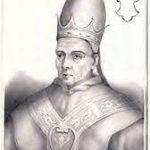
Pope St. Gregory II was the 89th pope in the Church and ruled for more than 15 years. Known for fighting with the Byzantine emperor of the time, he would influence later popes and the amount of power that they had. The Church recognizes him as a saint due to the miracle associated with him. If you want to learn about Pope St. Gregory II, read this article.
Early Life
Born Gregorius Sabellus circa 669, the future Pope St. Gregory II was a member of the wealthy Savelli family in Rome. His parents were Honesta and Marcellus. Sent to help with the papal court at a young age, he worked under Pope Sergius I and became the treasurer of the court. He was later ordained as a subdeacon and then made a deacon. This led to him working in the Vatican Library and eventually controlling the institution.
Papacy
When Pope Constantine died, the Church quickly elected Gregorius as the new pope. He then choose the name Gregory II. To help with the issues facing the Walls of Rome, the pope sent men to repair the broken areas. Rainfall made the task nearly impossible as it caused the nearby river to flood, but he would then send more men to stop the flowing waters and continue work on the Walls. Gregory II would also send men to do missionary work in Germany and other countries as a way to bring new followers to the Church.
Emperor Leo III
Much of the papacy of Pope St. Gregory II goes hand in hand with the rule of Emperor Leo III. Leo passed a new rule that increased taxes, but that rule would eliminate the reserves that the Church had. Gregory fought back, which would lead to the emperor dropping the rule but continue his opposition to the papacy.
Leo II would later make it illegal for anyone to own or have icons relating to a saint and issued other orders to rule in Rome. The emperor was even involved in a conspiracy to murder the pope. This would cause stress to the pope and lead to his eventual death.
Death and Burial
The issues that Gregory had with Leo III took their toll on his body. He suffered from stress, which was exacerbated by his advanced age. He was likely in his early 60s when he died several years after surviving an assassination attempt. The Catholic Church had Pope Gregory II buried in Saint Peter’s Basilica but later lost the records that show the location of his tomb. To honor his contribution and support, the Church canonized him as Pope St. Gregory II.
List of Events In The Life of Pope St. Gregory II
| Date | Age | Event | Title |
|---|---|---|---|
| 669 | Born | ||
| 711 | 42.0 | Appointed | Cardinal-Deacon |
| 711 | 42.0 | Elevated to Cardinal | |
| May 715 | 46.3 | Elected | Pope (Roma, Italy) |
| 19 May 715 | 46.3 | Ordained Bishop | Pope (Roma, Italy) |
| 11 Feb 731 | 62.1 | Died | Pope (Roma, Italy) |
Quick Facts About Pope St. Gregory II
- He was born in the Duchy of Rome and was a member of the Savelli family.
- Gregory II was born circa 669, which would make him 42 when he became pope.
- He died on February 11, 731.
- The pope died of natural causes while residing in Rome, Italy.
- His papacy began on May 19, 715.
- The papacy of Pope St. Gregory II ended on February 11, 731.
- His successor was Pope St. Gregory III.
Interesting Facts About Pope St. Gregory II
- Both Pope St. Gregory II and Pope Benedict II were members of the Savelli family. Dozens of politicians, military leaders and cardinals also belonged to this family.
- The Miracle at the Battle of Toulouse in 721 was the miracle that the pope did during his life and one of the reasons why he is a recognized saint. Tradition holds that he sent three small baskets of supplies to troops fighting Muslim soldiers in Toulouse. They managed to use those baskets to keep the troops alive for weeks, which led to their victory in the battle.
- Gregory II ranks as one of the longest-ruling popes in the Church’s history. His papacy lasted for more than 15 years between 715 and 731.
- Most of the illustrations of Pope St. Gregory II depict him wearing papal vestments, including the papal throne and a long coat with a collar that has crosses on it.
- The Catholic Church recognizes Pope St. Gregory II with a feast day held on February 11 every year, the anniversary of his death.